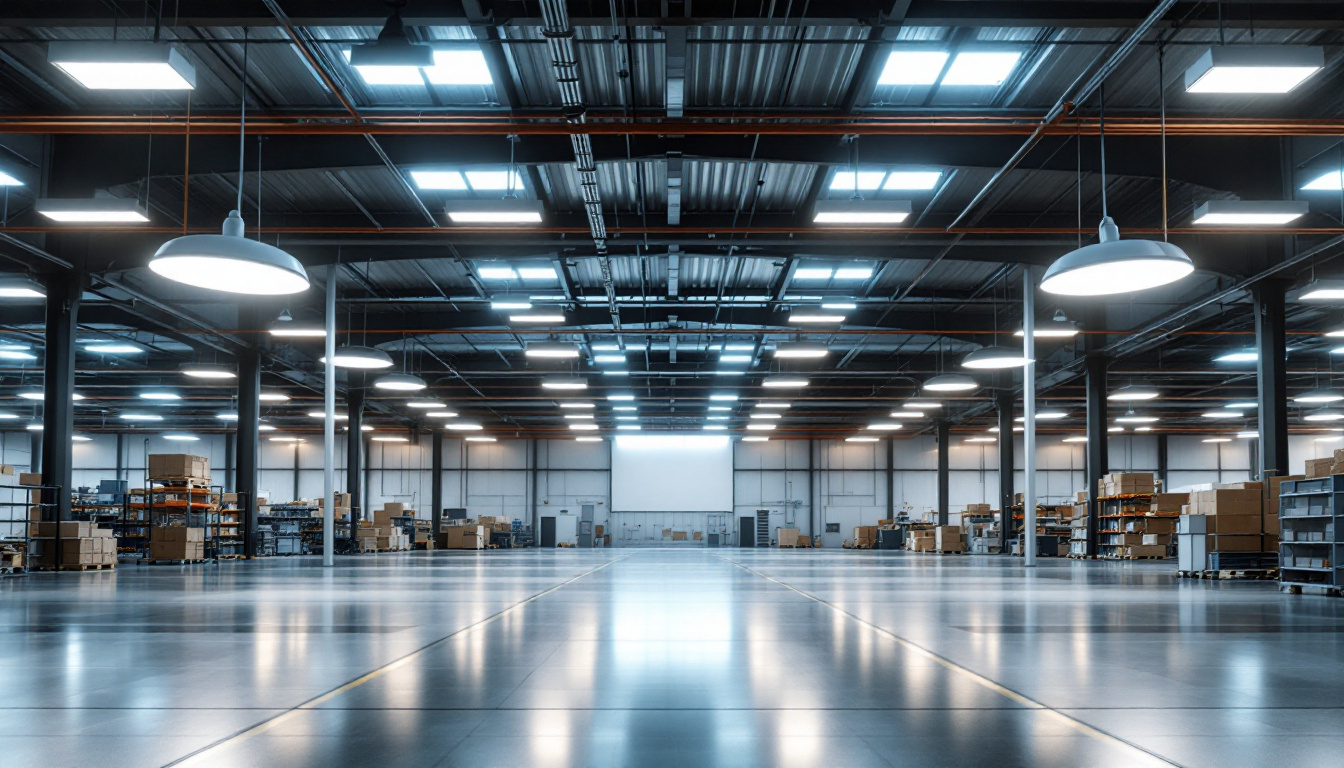
Lighting plays a crucial role in warehouse operations, impacting everything from safety to efficiency. As the demands of the industry evolve, so too must the approach to lighting projects. Future-proofing these projects is essential for ensuring that they remain effective and relevant as technology advances. This article explores the necessary warehouse fixtures and strategies to consider when planning lighting projects that can adapt to future needs.
Future-proofing lighting projects is not merely a trend; it is a necessity in a rapidly changing environment. As technology continues to evolve, the need for adaptable and efficient lighting solutions becomes increasingly critical. Warehouse operators require systems that can accommodate new technologies, such as smart lighting and energy-efficient solutions, while also ensuring safety and productivity.
Moreover, future-proofing helps in reducing long-term costs. By investing in versatile fixtures and systems today, businesses can avoid frequent upgrades and replacements, which can be both time-consuming and expensive. This proactive approach not only enhances operational efficiency but also contributes to sustainability goals.
As technology progresses, so do the capabilities of lighting systems. The integration of IoT (Internet of Things) in lighting solutions allows for enhanced control and monitoring. Smart lighting systems can adjust brightness based on occupancy or time of day, leading to significant energy savings. Furthermore, these systems can be managed remotely, providing flexibility and convenience for warehouse managers.
Incorporating advanced lighting technologies also means considering compatibility with existing systems. Choosing fixtures that can easily integrate with current infrastructure is vital for a seamless transition. This adaptability ensures that as new technologies emerge, warehouses can implement them without overhauling their entire lighting system. Additionally, the use of data analytics in conjunction with smart lighting can provide insights into usage patterns, enabling managers to optimize lighting schedules and further enhance energy efficiency.
Energy efficiency is a key consideration in modern warehouse lighting projects. With increasing energy costs and environmental concerns, selecting fixtures that minimize energy consumption is essential. LED lighting, for example, offers significant energy savings compared to traditional lighting options. These fixtures not only consume less power but also have a longer lifespan, reducing replacement frequency and waste.
Moreover, sustainable lighting solutions can enhance a warehouse’s reputation. Many companies are now prioritizing sustainability in their operations, and having energy-efficient lighting can be a selling point. By demonstrating a commitment to environmentally friendly practices, warehouses can attract clients and partners who value sustainability. Furthermore, implementing renewable energy sources, such as solar panels to power lighting systems, can further solidify a warehouse’s dedication to reducing its carbon footprint, creating a more resilient and responsible operation.
In addition to energy savings, sustainable lighting practices can contribute to improved employee well-being. Studies have shown that well-lit environments can enhance mood and productivity, which is particularly important in high-demand warehouse settings. By utilizing natural light where possible and employing tunable white lighting, operators can create a more inviting atmosphere that supports both efficiency and employee satisfaction. This holistic approach to lighting not only meets operational needs but also fosters a positive workplace culture, essential for retaining talent in a competitive market.
When planning a lighting project, selecting the right fixtures is critical. The following are some of the essential warehouse fixtures that can help future-proof lighting systems:
High-bay LED lights are ideal for warehouses with high ceilings, providing ample illumination for large spaces. These fixtures are designed to deliver high lumen output while consuming less energy. Their longevity and low maintenance requirements make them a cost-effective choice for warehouses.
Additionally, many high-bay LED lights come with smart technology options, allowing for features such as dimming and occupancy sensors. This adaptability not only enhances energy efficiency but also allows for customization based on specific operational needs. The integration of these smart features can lead to significant energy savings, as lights can automatically adjust based on the presence of personnel or the time of day, reducing unnecessary energy consumption during off-peak hours.
Moreover, the durability of high-bay LED lights is another advantage, as they are often constructed to withstand the rigors of industrial environments. With options for robust housing that resists dust, moisture, and impact, these fixtures can maintain their performance and appearance over time, ensuring that your warehouse remains well-lit and safe for workers.
Linear LED fixtures are versatile and can be used in various warehouse settings, from aisles to workstations. Their slim design allows for easy installation in tight spaces, while their uniform light distribution ensures that all areas are well-lit. This is particularly important for safety and productivity, as poor lighting can lead to accidents and inefficiencies.
Future-proofing with linear LED fixtures also involves considering their compatibility with smart controls. Many modern linear fixtures can be integrated with advanced lighting management systems, allowing for real-time adjustments and monitoring. This feature not only enhances operational efficiency but also provides valuable data analytics that can inform future lighting strategies and maintenance schedules.
Furthermore, linear LED fixtures often come with customizable color temperature options, enabling warehouses to create the ideal ambiance for different tasks. Cooler temperatures can be used in areas requiring high concentration, while warmer tones may be more suitable for break rooms or social areas, fostering a more comfortable environment for employees.
Task lighting is essential in areas where specific tasks are performed, such as packing or assembly stations. These fixtures provide focused illumination, enhancing visibility and reducing eye strain for workers. When selecting task lighting, it is important to consider adjustable options that can be repositioned as needed.
Incorporating task lighting that is compatible with smart technology can further enhance its effectiveness. For instance, adjustable brightness levels can be set based on the time of day or the specific tasks being performed, ensuring optimal working conditions at all times. This adaptability not only promotes worker efficiency but also contributes to overall job satisfaction, as employees are more likely to perform well in well-lit environments.
Additionally, the use of task lighting can be complemented by ergonomic design principles. By positioning fixtures to minimize glare and shadows, warehouses can create a safer and more productive workspace. This attention to detail in lighting design can significantly impact employee performance and morale, leading to a more engaged workforce.
The integration of smart lighting solutions is a significant step toward future-proofing warehouse lighting projects. These systems offer a range of benefits, from energy savings to enhanced control over lighting conditions. Understanding how to effectively implement these solutions is crucial for maximizing their potential.
Wireless control systems allow for easy management of lighting fixtures without the need for extensive wiring. These systems can be controlled via smartphones or tablets, enabling warehouse managers to adjust lighting levels, set schedules, and monitor energy usage from anywhere. This flexibility is particularly beneficial in large warehouse spaces where manual adjustments can be time-consuming.
Moreover, wireless systems can be easily expanded as the warehouse grows or changes. New fixtures can be added to the network without the need for additional wiring, making it a cost-effective solution for future expansions.
Incorporating occupancy and daylight sensors into lighting systems can significantly enhance energy efficiency. Occupancy sensors automatically turn lights on or off based on whether a space is occupied, reducing energy waste in areas that are not in use. Daylight sensors adjust artificial lighting based on the amount of natural light available, ensuring optimal illumination while minimizing energy consumption.
These sensors can be integrated into various types of fixtures, providing a comprehensive lighting solution that adapts to changing conditions. This adaptability not only contributes to energy savings but also enhances the overall working environment for employees.
When embarking on a lighting project, it is essential to consider not only current needs but also future requirements. This forward-thinking approach can help avoid costly upgrades and ensure that the lighting system remains effective over time.
Choosing fixtures and systems that offer scalability and flexibility is vital for accommodating future growth. As warehouse operations evolve, the lighting system should be able to adapt without requiring a complete overhaul. This means selecting fixtures that can be easily added or modified as needed.
Additionally, considering the layout of the warehouse is crucial. Designing a lighting plan that allows for easy reconfiguration can facilitate future changes in operations, whether that involves expanding storage areas or adjusting workstations.
Regular assessments of the lighting system are essential for identifying areas for improvement. Conducting periodic evaluations can help determine whether the current fixtures and controls are meeting operational needs. This proactive approach allows for timely upgrades and adjustments, ensuring that the lighting system remains effective and efficient.
Moreover, staying informed about new technologies and trends in the lighting industry can provide valuable insights for future upgrades. By being aware of emerging solutions, warehouse operators can make informed decisions that enhance their lighting systems and overall operational efficiency.
Future-proofing lighting projects in warehouses is a critical consideration for ensuring long-term efficiency and effectiveness. By understanding the importance of adaptability, selecting the right fixtures, and integrating smart technologies, warehouse operators can create lighting systems that meet current needs while being prepared for future advancements.
Investing in high-quality, energy-efficient fixtures, along with smart control systems, can lead to significant cost savings and improved working conditions. Furthermore, a proactive approach to planning and regular assessments will ensure that the lighting system remains relevant and effective for years to come.
Ultimately, the goal is to create a lighting environment that not only enhances productivity and safety but also aligns with the evolving demands of the industry. By prioritizing future-proofing in lighting projects, warehouses can position themselves for success in an ever-changing landscape.
Ready to take the next step in future-proofing your warehouse lighting? At LumenWholesale, we offer the spec-grade lighting solutions you need to enhance productivity and safety while staying ahead of industry demands. Our extensive selection of high-quality, energy-efficient fixtures is available at unbeatable wholesale prices, ensuring you get the best value for your investment. Say goodbye to inflated markups and hidden fees with our hassle-free bulk buying and free shipping. Elevate your lighting project today by visiting Wholesale Lighting at the Best Value and discover the LumenWholesale difference.

Discover the essential guide to outdoor emergency lighting, covering everything from types and features to installation tips and safety considerations.

Discover why ceiling light shops are essential for lighting contractors in this insightful article.

Discover the essentials of wall mount LED lights in just five minutes.

Discover how outlet plugs can significantly cut costs for lighting contractors by enhancing energy efficiency and minimizing waste.